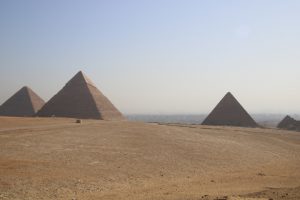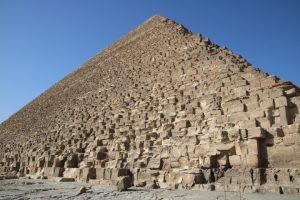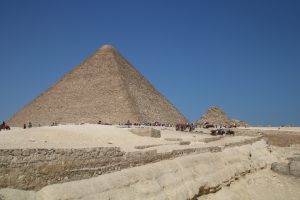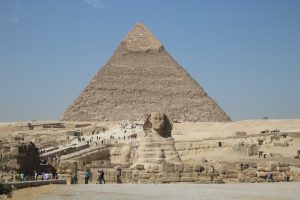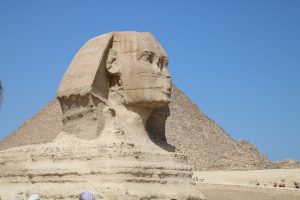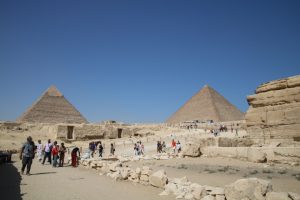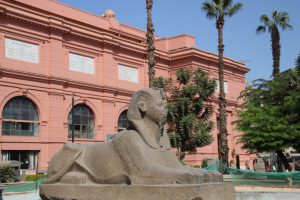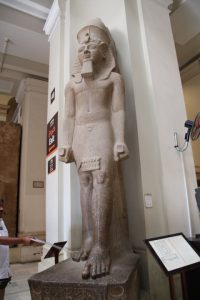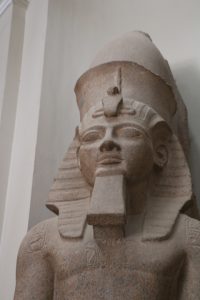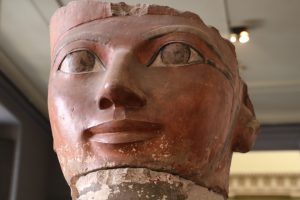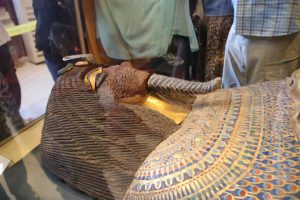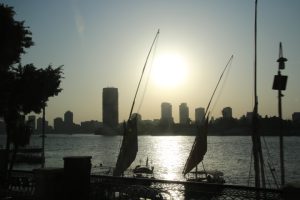This morning we arrived at the Giza Plateau just as it opened at 8:00 a.m. to visit the impressive Pyramids of Giza and the Sphinx.
The Great Pyramid is the only survivor of the Seven Wonders of the Ancient World. Nine kilometres from the river, the pyramids sit on top of the desert-covered West Bank escarpment. The Great Pyramid of Khufu is 137 m high and was completed around 2570 BC. The sheer bulk, extraordinary shape and impeccable geometry such as the alignment of the four corners to the cardinal points of the compass.
It was built as a tomb but there is no evidence inside that it was ever used. It is totally devoid of reliefs or paintings. It was possibly built as an astronomical tool. The astronomical studies of Robert Bauval, published in “The Orion Mystery” showed that four narrow “airshafts” should be more accurately called “starshafts”, since they would have aligned about 2500 BC with four prominent stars to which the Ancient Egyptians accorded immense ritual importance.
The second pyramid, Khafre’s, is 136m high and stands on slightly higher ground. It still has its peak encased in its polished limestone casing. The pyramid of Menkaure is the smallest of the three with only 1/10th of the bulk of the Great Pyramid.
Adjacent to the Great Pyramid is the hall containing a solar boat of Khufre that was designed to enable him to journey to the next world. It was unearthed in 1954 and is made from cedar from Lebanon. Below the pyramids is the Sphinx, a sculpture of a man with the body of a lion. It was carved from the bedrock at the bottom of the causeway leading from the Great Pyramid and is assumed was constructed during Khafre’s reign, or was it?
Studying it today it can be seen that the head is carved from a slightly different and more resistant limestone than that of the body which comes from the limestone that surrounds it. There is evidence of wind and sand erosion but also by rain water run-off and V-shaped channels in the back wall of the enclosure and in the desert above it. The removed limestone was used as the walls of the Valley Temple nearby but which is only encased in granite and not built exclusively from it. This theory is not accepted by many Egyptologists. This theory results from the work of geologist Dr Robert Schoch who suggests that the body and temple maybe thousands of years older than the accepted assumptions.
During the afternoon we visited the Egyptian Museum in Tahir Square.
It is a mass of cabinets containing ancient jewellery, statues and other artefacts with walls lined with large statues, reliefs and papyrus spread over 107 halls. It is currently in a state of flux as the new Grand Egyptian Museum at Giza is nearly ready for opening so many of the artefacts have been transferred there and we saw some that were boxed and ready to go their new home and some to the new Amarna Museum. We concentrated upon Akhenaten as we had visited his new capital at Amarna.
We could not however, leave the museum without seeing the Tutankhamun Gallery and in particular his 11kg solid gold death mask which we first saw in 1972 at the British Museum. Photography is unfortunately not allowed anymore but we do have photographs from the past.
